The Quebec Whale Route: Must See Stops Along the Route des Baleines

Canada has no shortage of incredible road trips and the Quebec Whale Route aka the “Route des Baleines” is certainly one of them. Located in the Côte-Nord Region, it is home to pristine natural beauty, incredible cultural experiences, national parks, unique accommodation options and much more. Follow the north shore of the St Lawrence River to uncover the plethora of adventure that awaits. You’ll quickly see why you need to add the Route des Baleines to your Canada bucket list!
Disclaimer: This post is brought to you in partnership with Le Québec maritime. It contains affiliate links where I may receive a kickback at no extra cost to you. It helps keep IBB alive so thank you!

Keep An Eye Out for the Whale As You Travel Route 138!
TABLE OF CONTENTS
Where is the Quebec Whale Route?
Let’s start with the basics because I think it’s safe to say that, like many of my fellow Ontarians, our geographical knowledge of Quebec is pretty terrible.
The Côte-Nord Region (translating to North Coast) encompasses over 247,000 square kilometres of the province from Tadoussac to the far east border with Labrador to Brisay in the north. It’s almost the same size as the state of Michigan! For more fun facts, check out this article from Le Québec maritime.
The Quebec Whale Route (Routes des Baleines) is the nickname given to Route 138 which connects Tadoussac to Kegaska as it follows the north shore of the Saint Lawrence River. It actually begins at the border of New York State, southwest of Montreal and it goes throughout the regions of Montérégie, Montreal, Lanaudière, Mauricie, Québec City, Charlevoix and Côte-Nord. Check out this Quebec Whale Route map to get a better idea of this stretch of highway.
Why is it called the Whale Route? That’s thanks to the fact that over 10 whale species are known to frequent the area – 13 to be exact! While it’s never a guarantee, there’s a reason why Tadoussac and other destinations along the Whale Route are some of the best places to go whale watching in Canada.
If you’re contemplating a road trip to Eastern Quebec, this area should really be on your radar. With unbelievable scenery, fascinating history and heaps of things to see and do, this is one epic Quebec road trip! Let’s dive into the details, shall we?
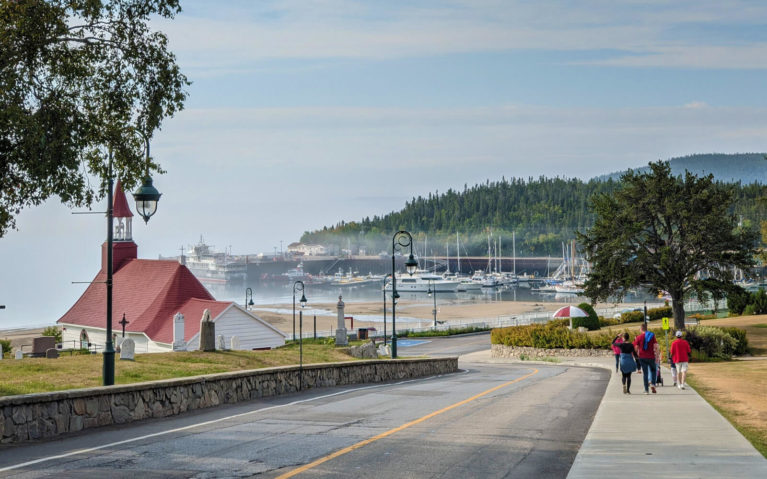
Views As You Walk to the Waterfront in Tadoussac
Stops to Make Along the Route des Baleines
With the route spanning almost 900 kilometres, you can imagine there is plenty to explore along the Whale Route. Let’s take a look at some of the must-see stops that make the Côte-Nord Region truly unique.
Tadoussac
Start your adventure in the first and oldest French settlement in North America, Tadoussac. It was founded in 1600 and due to its ideal location, it served as a hub of the fur trade between European settlers and the Innu People. While the town is home to just 800 people, it’s a popular destination in Eastern Quebec. Why? For the whales!
The Saguenay–St. Lawrence Marine Park is known as one of the best spots not just in the country but in the world to see whales in their natural habitat! You have the chance of witnessing up to 13 different whale species, including the largest animal on the planet – the blue whale. There are several ways you can experience these beautiful creatures safely and respectfully. For more details, check out this great guide to Quebec whale watching from my friend Gemma over at Off Track Travel. Oh, and don’t forget to stop by the Marine Mammal Interpretation Centre in Tadoussac to learn more about the whales of the St Lawrence!
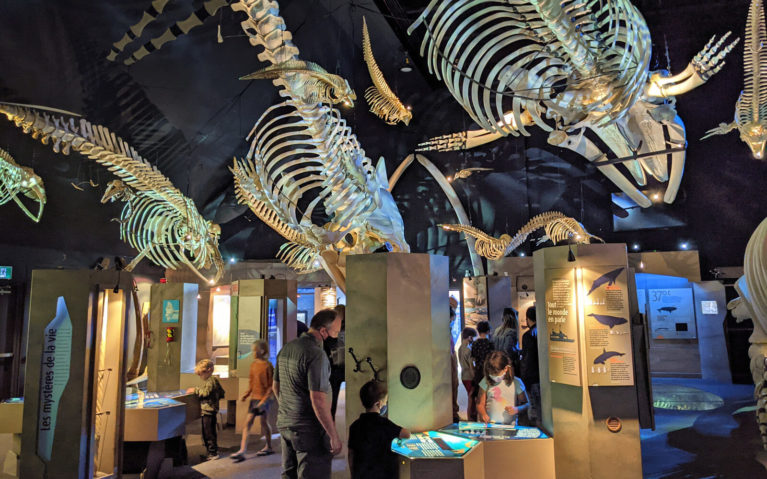
Exhibits Inside the Marine Mammal Interpretation Centre
Ever heard of nordic snorkelling? Head over to the Marine Environment Discovery Centre to see the diverse marine life of the St Lawrence River for yourself! Don’t worry, you’ll be given a thermal wetsuit, flipper and a snorkel so that you’re nice and toasty warm as you dive into the river’s cold waters. If you’d rather stay on land, there are a number of tours and presentations available to learn more about the marine mammals which inhabit the area.
If you’re wondering where to stay in town, there are certainly a number of great hotels in Tadoussac. However if there’s anywhere to call home base, it has to be the Hôtel Tadoussac. A landmark since 1864, the hotel is brimming with old world charm with its turn-of-the-century architecture. Facing Tadoussac Bay, you’ll be treated to spectacular views and its location in the heart of town makes it the perfect spot to stay. My waterfront-facing room had plenty of space as I slept soundly all cozied up in my queen size bed. See what others have to say about their experience or book your room at the Hôtel Tadoussac now!
While there are many great hotels to stay at in Tadoussac, if you’re a fan of unique experiences then you’ll want to head to Sacré-Coeur. Located just 20 minutes northwest of Tadoussac, you’ll find Canopée Lit. Established by a family from France, they have built an adorable complex in the heart of the forest. They have 4 all-season treetop cabins (2 even have a view of the Saguenay Fjord!), 4 summer treetop cabins with glass domes for stargazing and 6 treetop “bubbles” that are completely see-through! If you’re worried about privacy, don’t worry. You’re up in the trees so you’ll only have to worry about the local wildlife!
RELATED: Before you choose to carry on along Route 138, you might want to head northwest and explore the Parc national du Fjord-du-Saguenay. Part of it is in the Côte-Nord Region and can be accessed from Sacré-Coeur. With incredible hiking trails and biking routes, I recommend experiencing some of the natural beauty of the Saguenay Fjord. You can find more details in my post about the Saguenay–Lac-Saint-Jean area!
Les Bergeronnes & Essipit
Just 20 minutes east along Route 138, you’ll find Les Bergeronnes. This tiny town boasts plenty of year-round activities such as hiking, cycling, sea kayaking, snowmobiling and more. If you’re into archaeology or just a history buff, you won’t want to miss the interpretation centre which shares all the fascinating details about the 22 local archaeological sites in the area. Similar to Tadoussac, this area is also famous for whale watching though if you’re going to pick one or the other, I highly recommend Vacances Essipit.
Essipit is the Innu reserve which was established by the Government of Canada in 1892. It cut off the Innu People from their natural corridors due to the quick development of the forestry industry and this, compounded with years of becoming sedentary due to European colonization, forced the Innu People to adapt to this harsh reality. In 1978, the community reinvented itself with a focus on tourism, sharing the nature found in the heart of Innu lands with those who visit.
By taking a whale watching tour in Essipit, you’re not only supporting the Innu community but you’ll find yourself surrounded by the culture. Plan to spend some time in Essipit learning about the Innu way of life. You can even stay in one of their beautiful A-frame cottages, located right on the shores of the St Lawrence River. Visit the Essipit website for more information on all it has to offer but let me tell you, this is easily the best whale watching tour in Tadoussac. Err, I guess near Tadoussac? Your guides will do everything they can to ensure you see as many whales as possible (safely, of course) as you zip around in a zodiac. Be prepared for a wild ride but I promise it’s the experience of a lifetime!
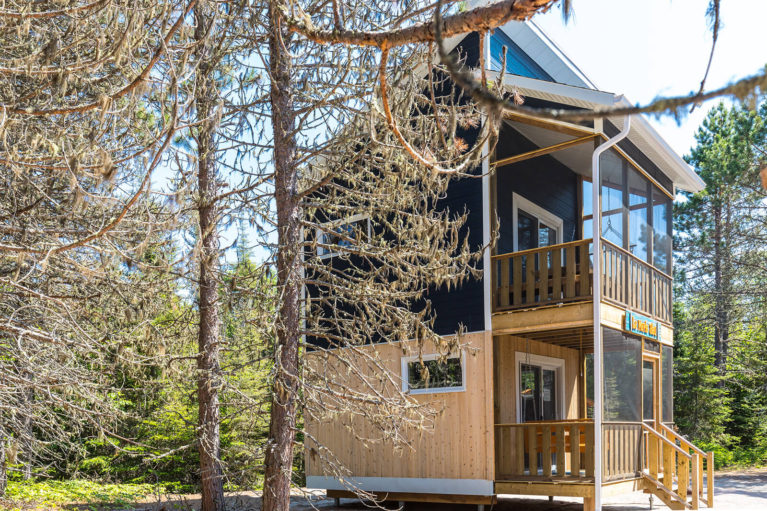
Sleep in a “Birdhouse” Cottage at Parc Nature de Pointe-aux-Outardes – Photo Credit: Mathieu Dupuis/Le Québec maritime
Baie-Comeau
What started with the humble beginnings of the first sawmill ever built in the region, Baie-Comeau has since grown into one of the largest cities in the Côte-Nord Region. So, what all is there to see and do? The short answer… lots!
Baie-Comeau is actually one of the many towns and villages along the St Lawrence River that are located within the Manicouagan-Uapishka World Biosphere Reserve. Approximately 214 million years ago, an asteroid approximately 8 kilometres in diameter impacted the earth, forming the “Eye of Quebec” – the Manicouagan crater. “Manicouagan” is said to mean Place where Tree Bark is Found in the Innu language and “Uapishka” refers to the Groulx Mountains and means white summits. Take a look at the Manicouagan-Uapishka website to learn more!
NOTE: In some documents and websites, you may see the term Montagnais used instead of Innu. This was the name given to the Innu People by European settlers so I am choosing to use Innu as this how they identify themselves in their language.
If you’re all about the local experiences like I am, then Baie-Comeau is a must-visit. This is where the foodies come to play! Treat yourself to the flavours of the region at what is said to be the top restaurant in the city, La Cache d’Amélie. For over 25 years, they have been sharing “boreal cuisine” and those flavours inspired by the land and sea. Afterwards, head to Microbrasserie St-Pancrace to try their Crâââbe beer that’s brewed with crab shells! Sounds a little too weird? Not for me, it’s actually quite delicious! It doesn’t taste fishy by any means but rather a hint of sea air if that makes sense. I can see why they always sell out so quickly!
Did you know you can explore nine (that’s right, NINE) different ecosystems in a single day? It’s true! Head to Parc Nature de Pointe-aux-Outardes where you can enjoy the boreal forest, sand dunes, a salt marsh and more. It’s also said to be one of the best spots for birdwatching in Quebec! Though if you’re lucky, you’ll be able to speak with an Innu elder during your visit so that you can learn more about the traditions of the Innu People.
There are some great accommodation options in Baie-Comeau. Though if you’re going to stay anywhere, it has to be at the Parc Nature de Pointe-aux-Outardes in one of their five giant birdhouses! Each one is inspired by a species of bird found within the park meaning you’ll have to return again and again so you can experience them all. They’ve truly gone the extra mile as your bed is even cozied up inside a giant nest! It is a little outside the city so it might make for a good spot to stay before making your way fully to Baie-Comeau, but you really don’t want to miss out on this unique accommodation option in Quebec.
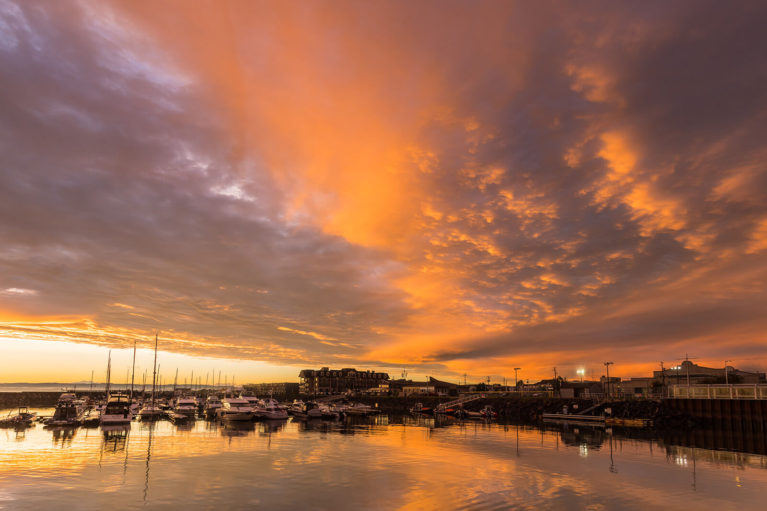
Sept-Îles Marina at Sunset – Photo Credit: Mathieu Dupuis/Le Québec maritime
Sept-Îles
Hop back on Route 138 en route to your next destination, Sept-Îles. Before you get here though, make sure to pay a visit to the second oldest lighthouse in Quebec, the Pointe-des-Monts Lighthouse.
Said to be one of the most photogenic, it’s surrounded by gorgeous shoreline that will have you mesmerized as the waves come crashing in. Step inside the heritage museum to learn about the history of the lighthouse, the lives of its lightkeepers and the local shipwrecks. Though chances are the highlight will be the mesmerizing views from the top! A little over an hour from Baie-Comeau and then another two hours until you reach Sept-Îles, it makes the perfect rest stop to break up your drive.
Now, say bonjour to the largest city in the Côte-Nord Region! Sept-Îles is named after the seven islands that protect the city’s round bay. While aluminum is the main industry in Sept-Îles, there is great emphasis on experiencing nature in the city. After the three hour drive from Baie-Comeau, you’re probably hungry so let’s start with some of the great eats to be found in Sept-Îles!
Fishing is a large economic sector and as such, you’ll find plenty of incredibly fresh seafood just waiting to be devoured. While some restaurants can be a little pricey, head to Casse-Crôute du Pêcheur right on the water. Here you can unique eats like seafood egg rolls and seafood poutine inside of a giant lobster trap! If you’re looking for dessert, step up to the lighthouse for a scoop or two of ice cream. I’d say this is probably the most unique restaurant experience you’ll find in the entire Côte-Nord Region!

Be Sure to Indulge in the Regional Flavours – Photo Credit: Mathieu Dupuis/Le Québec maritime
Now that you’ve refuelled, let’s take a look at some of the great experiences you can enjoy in Sept-Îles. While we’ve explored quite a bit of the Côte-Nord Region already, we haven’t learned much about the history! Head to the Musée Régional de la Côte-Nord to change this at their permanent exhibit which shares some of the stories and events that have happened in the past 8,000 years. This will surely give you a glimpse of the true character found in the Côte-Nord Region!
If you’re like me and are very interested in the stories and knowledge of the original inhabitants of this land, a visit to the Musee Le Shaputuan is a must. Take your time exploring the millennia-old history of the Innu People and learn about their traditional way of life on these ancestral lands. Follow the Innu way of life through the seasons as they followed the natural resources available to them and see their traditions when gathering with other nations for trade along the banks of the St Lawrence.
I mentioned earlier that Sept-Îles is known for the beautiful nature surrounding it, so let’s get out and explore some of it! I mean, you can’t visit Sept-Îles without exploring its namesake, the Sept-Îles Archipelago. Each of these seven islands displays a distinctly unique feature of the region’s biodiversity. Enjoy a zodiac tour to see them all from the water and then head to Grande Basque island. Enjoy the 11 kilometres of hiking trails or spend the night at one of the 20 wilderness campsites to truly experience the archipelago!
Ever wanted to try your hand at surfing? Well, you can give it a shot here in Sept-Îles with SurfShack! They have everything you need from gear to rentals so you can tackle the gnarly waves of the Gulf of St Lawrence. Sign up for a class and see if you can manage to ride a wave or two! If surfing isn’t your jam, they also have stand-up paddleboards for rent so you can get your SUP on instead.
This is just a teaser as Sept-Îles really has so much to offer. I haven’t even talked about its incredible beaches, the Old Fur Trading Post or the Agara Native Art Gallery… but that just means you’ll have to visit and explore for yourself. For now, onwards to our next stop!
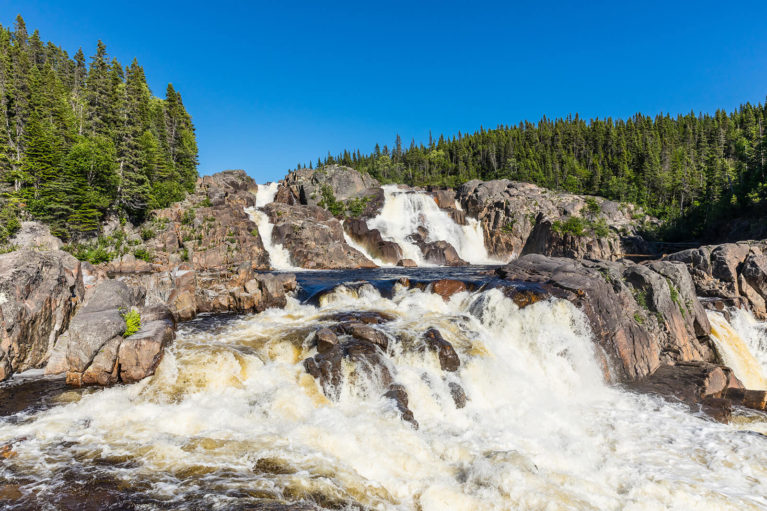
The Majestic Falls Along the Rivière-au-Tonnerre – Photo Credit: Mathieu Dupuis/Le Québec maritime
Rivière-au-Tonnerre
With a name that translates to Thunder River, you know you have to stop and see for yourself. Rivière-au-Tonnerre is named after the roar of its river. Be sure to visit the Falls of Petit Sault and Grand Sault, a set of brilliant waterfalls along the Thunder River. While the Petit Sault Falls are visible from the village, you’ll have to head 8 kilometres north to witness Grand Sault Falls but don’t worry, they’re worth the detour!
I’m not a religious person but even I’m intrigued by the Saint-Hippolyte Church and recommend you stop by for a visit. This blue-hued church was built by over 300 volunteers who followed a traditional Norman-style cross plan. Inside you’ll find approximately sixty sculptures, all carved with a pocket knife!
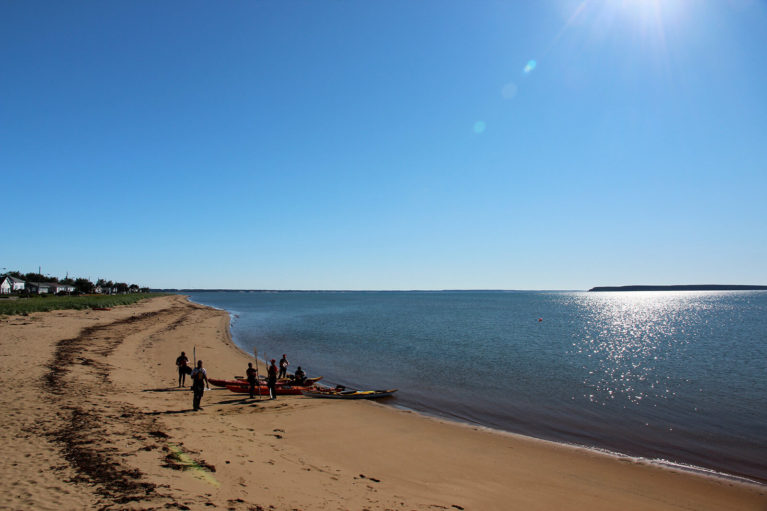
Kayakers on a Beach in Havre-Saint-Pierre – Photo Credit: Éric Marchand
Mingan & Havre-Saint-Pierre
Another 45 minutes east along the Quebec Whale Route and you’ll find yourself in Mingan. Also known as Ekuanitshit in the Innu language, it’s located at the mouth of the Mingan River on Mingan Bay, part of the Gulf of Saint Lawrence. The community isn’t very large at approximately 600 residents, but it’s home to the Maison de la Culture Innue, a must-visit along the Route des Baleines.
The museum is built on the site where the traditional Innu camp would stand in the summer months. Designed by the community for the community, it’s a place where both locals and visitors can gather to learn more about the Innu way of life. Also, be sure to stop by the traditional site featuring a Shaputuan (big tent) where you can bake bannock and cook traditional game meats.
Afterwards, continue on for another 30 minutes and you’ll arrive at Havre-Saint-Pierre. Enjoy the breathtaking panoramic views of the Gulf of St Lawrence as you explore this sandy point along the shore. One thing you might notice is the Acadian flag hanging at various places in town. This is to commemorate their origins as the people of Havre-Saint-Pierre officially claim to be ‘Cayens’ – a common variation of Acadien aka Acadian.
I’ve been lucky enough to already have a taste of Havre-Saint-Pierre thanks to Le Québec maritime as they sent me a bottle of Betchawan Gin from Distillerie Puyjalon. As some of the smoothest gin I’ve ever had the pleasure of tasting, I’ll be certainly planning a visit when I’m in town! Distillerie Puyjalon is actually the first micro-distillery in the Côte-Nord Region and utilizes botanicals from the area to create their fine products.
However, chances are you’re in Havre-Saint-Pierre to experience the incredible destination just off-shore…

The Famous Monoliths of the Mingan Archipelago National Park Reserve – Photo Credit: Mathieu Dupuis/Le Québec maritime
Mingan Archipelago National Park Reserve
Established in 1984, the Mingan Archipelago National Park Reserve is one of the big reasons visitors travel from all over to visit the Côte-Nord region. Havre-Saint-Pierre is one of the two towns (the other being just west of Mingan) where you can travel by boat to experience this incredible Parks Canada site.
This national park reserve was established to protect the incredible limestone monoliths scattered throughout the cluster of 40 islands, along with the variety of wildlife it houses. There are so many incredible things to do in the Mingan Archipelago National Park Reserve that you’ll want to plan at least a day or two here!
Hop on a boat tour and gaze at the monoliths of Île de la Fausse Passe. You’ll be mesmerized by the extraordinary cliffs of Île Saint-Charles. Hike along the Les Falaises trail for stellar views of the Île Quarry shoreline. Plan some time to admire the adorable puffins who frequent Île aux Perroquets in July.
As for accommodation, you have quite a few options! There are a number of front-country campsites across six of the islands within the Mingan Archipelago National Park Reserve. Each one is equipped with a tent pad, picnic table and fireplace, all in close proximity to a dry toilet, a woodbox and firewood. However, you might want to upgrade a little as there are some seriously cool lodging options in the park!
Stay in one of the two brand new Ôasis teardrop cabins located within the park. These brilliant blue accommodations are absolutely gorgeous and will certainly make an already memorable stay even more so! Of course, there’s the Parks Canada oTENTiks which are fully furnished, heated, list and sleep up to 6 people. Though if you’re not much of a camper, then you’ll definitely want to book a night or two inside Île aux Perroquets lighthouse station! Here you’ll enjoy the four star treatment as you enjoy local treats, cocktails on arrival and a superb breakfast as well as unlimited access to this historic lighthouse.
Once you’re done exploring, it’s time to head back to the mainland and to your final destination along the Quebec Whale Route!
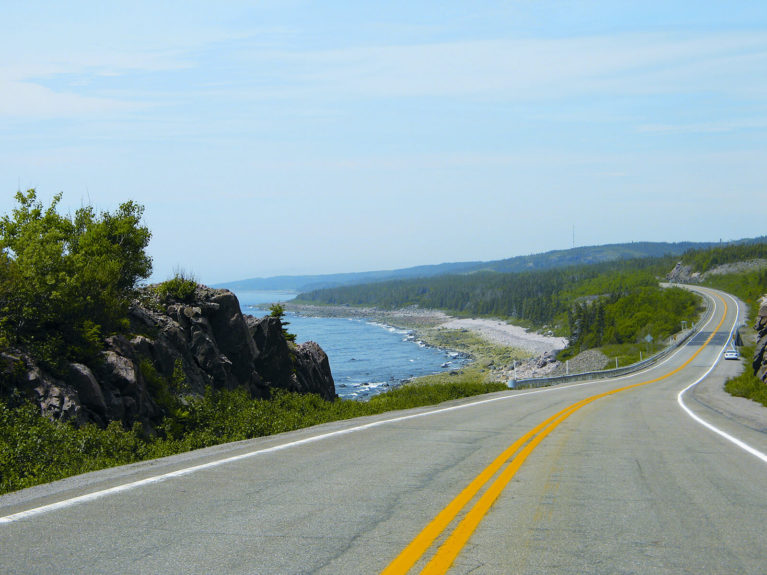
Some of the Views You’ll Find Along Route 138 – Photo Credit: Artiom Kusci/Tourisme Côte-Nord – Manicouagan
Kegaska
Say hello to the end of the road! I’m serious. Here is where the driveable part of Route des Baleines officially ends as the road between Natashquan and Kegaska was only completed in 2013. If you want to continue onwards, you’ll need to take a cargo ship to Old Fort, Quebec in order to reach the continuation of Route 138 to Blanc Sablon and then Labrador.
Kegaska was once fuelled by the cod industry though the village’s economy is now centred around crab, lobster and scallop fishing. While the town is tiny with just 90 people residing there, it’s still worth driving to the end of Route 138.
So, why go all the way to Kegaska? The town is known for its incredible white sand beaches. Enjoy a stroll along the shoreline and spend some time digging for clams, watching for birds and keep your fingers crossed for a whale sighting! Kegaska is also home to iconic hiking trails of crushed shells. Where else in the world have you heard of that?! Be sure to explore the Brion Trail which takes you to what remains of the Brion cargo ship which sunk near the town in 1976.
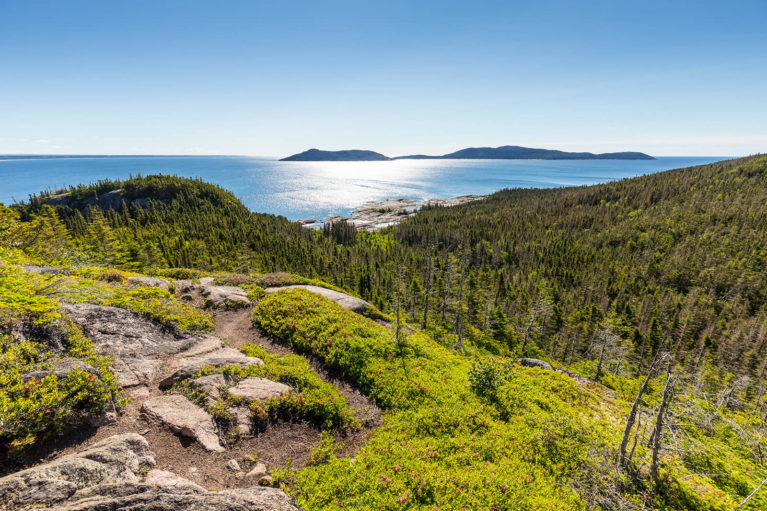
Views From the Sept-Îles Archipelago – Photo Credit: Mathieu Dupuis/Le Québec maritime
Quebec Whale Route Itineraries
As you can see, there is a lot to experience along Route 138. So much that it might be hard to know how long to spend in the Côte-Nord Region!
While longer is always better, you’ll want to spend at LEAST 5 days enjoying Route 138. Starting in Tadoussac, beeline it all the way to Kegaska. Why start at the end and work your way back? That way you’ve got the long drive out of the way and you can take your time enjoying the route as you slowly return to Tadoussac. On day 2, you’ll want to go from Kegaska to Havre-Saint- Pierre. Day 3 will take you to Sept-Îles and then to Baie-Comeau on day 4 so that you finish day 5 back in Tadoussac. This keeps the driving to no more than 3 hours a day so that you can get a taste of each destination.
Obviously, that doesn’t give you a whole lot of time in each destination and it means you’ll have to skip quite a few of the destinations in between. Personally, I would recommend aiming for at least a week, if not 10 days. This way you can spend two nights in a few of the larger destinations like Baie-Comeau and Sept-Îles or enjoy an off-shore overnight excursion like a night at the Mingan Archipelago National Park Reserve.
If you were to tackle everything I’ve listed in this post, I’m going to say you’ll probably need two weeks to fully enjoy it all. I enjoyed it in 12 days and that honestly wasn’t even enough. My list of places to return to is just as long as the list I had when I arrived! With so many unique experiences along the route, it’s certainly not to be rushed. However, if you are limited on time, you can always fully explore smaller sections (from Tadoussac to Baie-Comeau for example) and then return and explore the rest on another trip.
So, all that’s left is for you to decide how long to stay! I mean, you know my answer will be to stay for as long as you can. If you’re not able to do everything in this post though, that just means you’ll have to return!
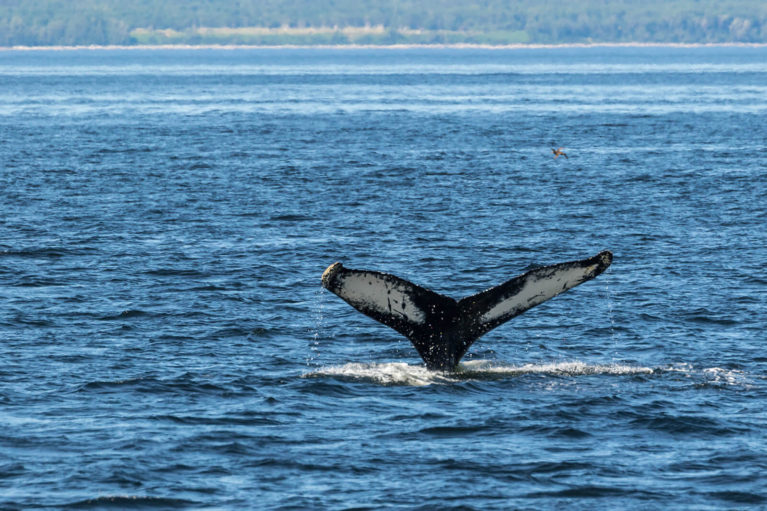
Whale in the Saguenay–St. Lawrence Marine Park – Photo Credit: Mathieu Dupuis/Le Québec maritime
Get Planning Your Visit!
Ready to experience the Quebec Whale Route aka the Route des Baleines? As you can see, there is SO much to see and do that you’re guaranteed to have the trip of a lifetime. If you have any questions at all, pop them in a comment below and I’d be happy to answer them!

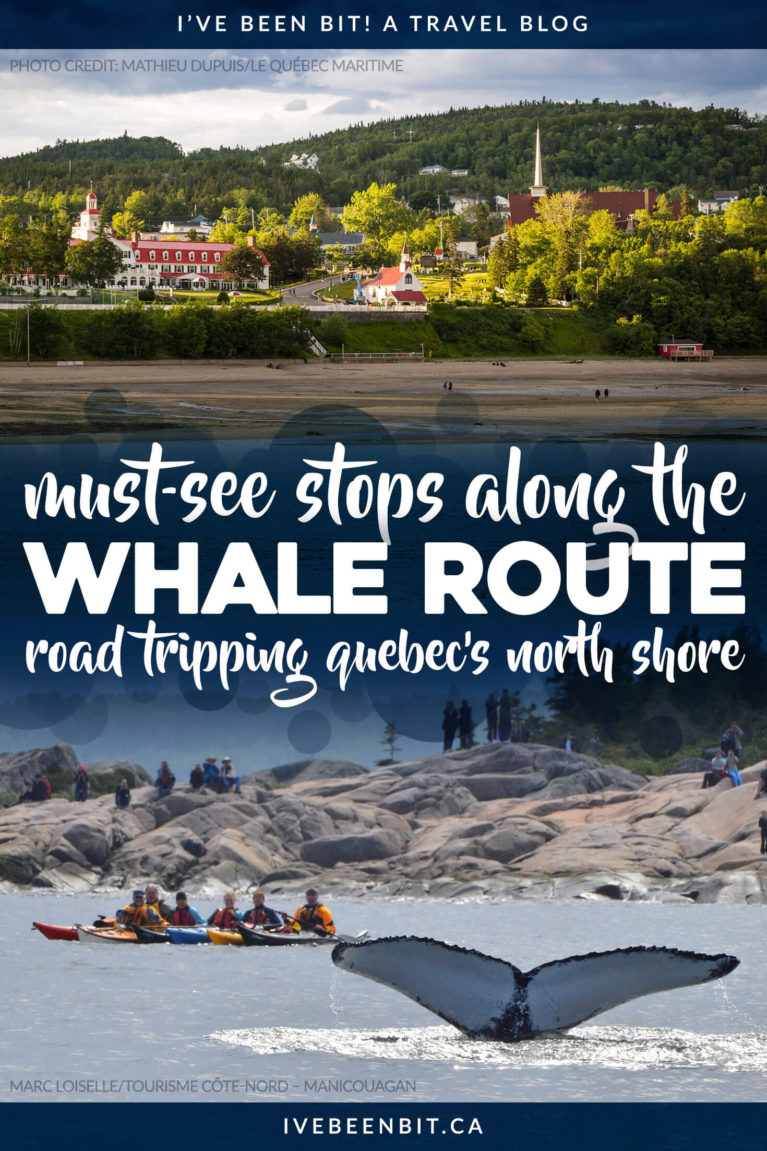

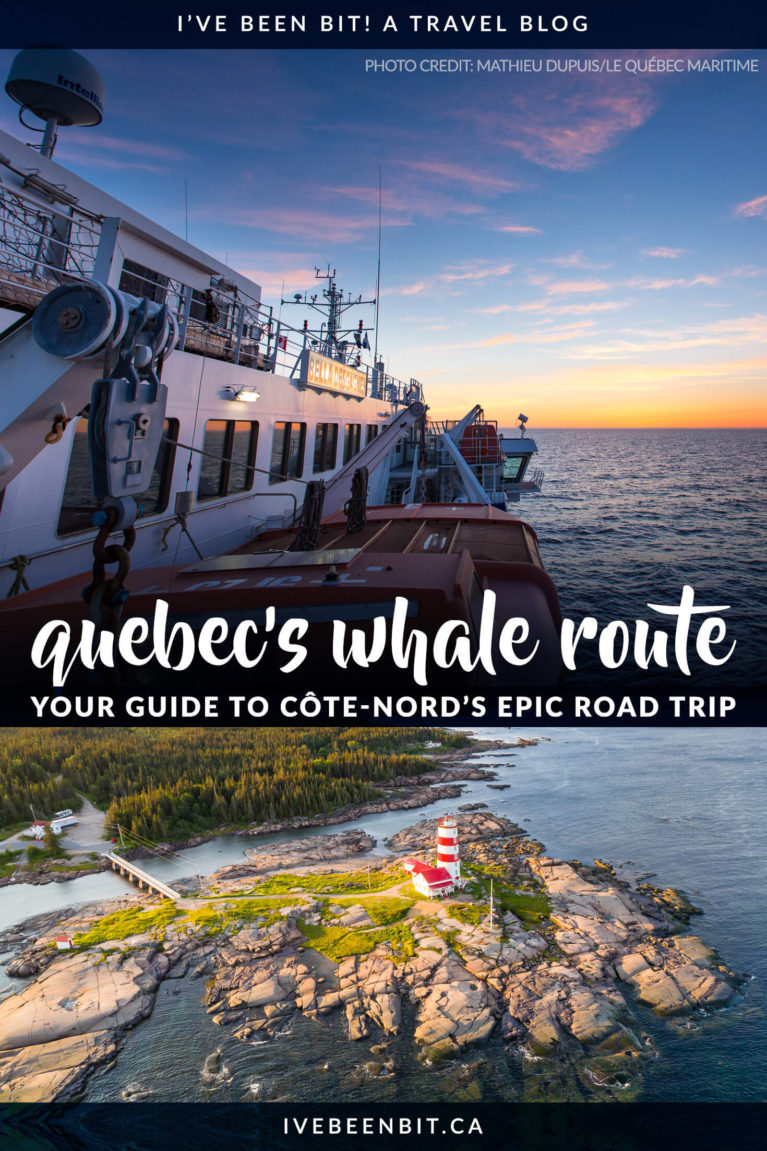







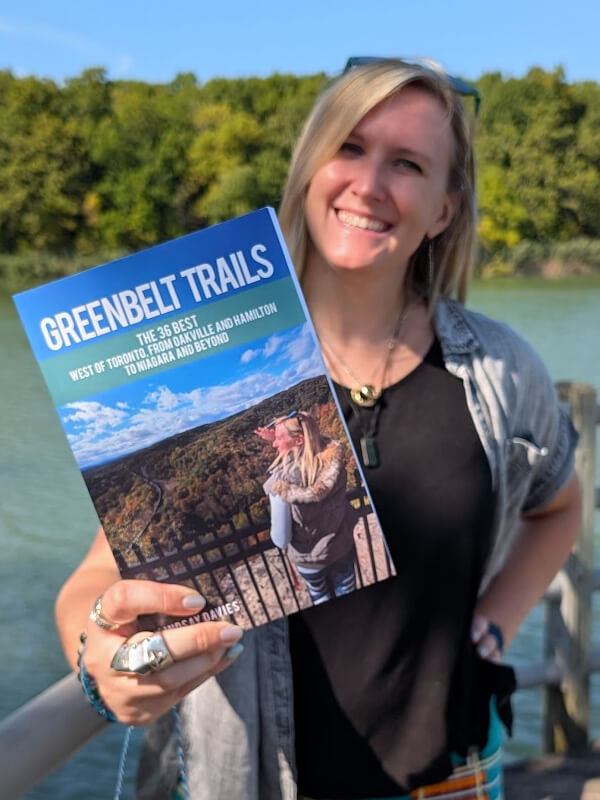


kmf
Would love to road trip along Quebec’s whale route in the future! So many cool must-stop places!
Lindz author
Right?! I was absolutely mesmerized by all these incredible stops and I can’t wait to see how many more I’ll find once I actually do the trip!
Krista
Every time I go to Quebec I mean to go on that route but I never have time! It looks like there are a lot of nice spots along the coast to see!
Lindz author
I’m so happy to hear that you know of Route 138! I hope my post has inspired you to check it out sometime!
Jamie Sharpe
That is such an amazing trip. Every time I’m in Quebec I spend time in the cities but now I need to get out! Thanks.
Lindz author
Yesss I totally get this! I’ve experienced very little of Quebec outside the major cities like Montréal and Québec City but I can’t wait to hop on this trip myself and truly check out some of the smaller gems of the province 🙂
Josy A
Wooowza Lindz! What a gorgeous area – the route de baleines looks like East Coast heaven!!
I especially love the look of the food (I would expect no less in Quebec) and the Monoliths of the Mingan Archipelago National Park Reserve are sooo cool!
Lindz author
RIGHT?! Researching this post has me ITCHING to hit the road. I so hope I can make the trip this summer – and you KNOW I’ll find all the top-notch eats 😉 I’ll be sure to share on social haha!!
Kay
I’ve only been to the city of Montreal, so I would love to see more of Quebec. I must admit though, I’m kinda terrified of whales haha. Maybe I’ll stay a bit closer to the waterfalls at the Rivière-au-Tonnerre haha
Lindz author
Hahaha I TOTALLY get that considering whales are MASSIVE. I feel like seeing them on land would be a-okay but I’d be lying if I wasn’t a wee bit nervous about possibly seeing them from a kayak. I’ll 100% be brushing up on my swimming skills before I get on the water LOL! I’d say that the plan to stick closer to Rivière-au-Tonnerre is also a very good one 😉 Can never go wrong with some waterfalls!
Carina
13 species of whale? Count me in! And could I please get a plate of this lobster?
Lindz author
RIGHT? Isn’t that incredible?! I can’t wait to do some whale watching and see how many of the 13 I’ll be able to spot!
Lannie
I had no idea there was a whale trail in Quebec! I know that Scotland had just come up with something similar as well. Looks like there’s so much to see besides the whales! The monoliths looks so incredible!
Lindz author
I’m so glad I could share this beautiful route with you! Quebec surely is full of surprises and I agree, there’s so much to see… and eat! I can’t wait until I can explore it all myself 🙂
John
This road trip would be positively huge. It’s a lot of road to cover before you even think about getting on the water for the whales. You seem to have researched it very well. Hopefully someday I’ll get to east Canada and be able to benefit from this blog.
Lindz author
Haha right?! There sure is so much to explore along the ~850km stretch of highway! I think I’m most excited to get out on the water though, it’ll be amazing to go whale watching and explore the natural beauty of the area!
I hope you’re able to get out to Quebec one day too. When you do, please let me know as it would make my day to know that my blog helped you plan your adventure!